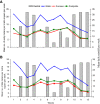The ecology of mosquitoes in an irrigated vegetable farm in Kumasi, Ghana: abundance, productivity and survivorship
- PMID: 23069265
- PMCID: PMC3485118
- DOI: 10.1186/1756-3305-5-233
The ecology of mosquitoes in an irrigated vegetable farm in Kumasi, Ghana: abundance, productivity and survivorship
Abstract
Background: Irrigated vegetable farms within the city of Kumasi, Ghana, create hotspots for the breeding of malaria vectors, which could lead to high transmission of malaria. This study investigated the abundance and productivity of mosquitoes in an irrigated vegetable farm in Kumasi, Ghana.
Methods: Adult mosquito productivity was estimated five days in a week in different irrigated scheme types (dug-out wells, furrows and footprints) for 12 weeks using emergence traps. Larval sampling was done five days a week to estimate the abundance of larvae from the different irrigated schemes types.
Results: Mosquito breeding in the irrigated vegetable field was confined to dug-out wells, furrows and human footprints. Mosquito productivity (m2/week) was highest in the dugout wells followed by the human footprints and the least was in the furrows (11.23, 5.07 and 4.34 An. gambiae/m2/week). Larval abundance for the late instars (3rd, 4th and pupae) also followed the same trend, with the dug-out wells having the highest larval abundance followed by the human footprints and then the furrows (13.24, 6.81, 5.87 larvae/week). Mosquito productivity and abundance was negatively correlated with rainfall (R2 = 0.209; P< 0.01).
Conclusion: This study showed that adult and larval mosquito abundance and larval survival were high in the irrigated fields in the irrigated vegetable farm. This therefore, contributed significantly to adult mosquito populations and hence malaria transmission in the city.
Figures


Similar articles
-
Larval habitat diversity and Anopheles mosquito species distribution in different ecological zones in Ghana.Parasit Vectors. 2021 Apr 7;14(1):193. doi: 10.1186/s13071-021-04701-w. Parasit Vectors. 2021. PMID: 33827667 Free PMC article.
-
Effects of environmental modification on the diversity and positivity of anopheline mosquito aquatic habitats at Arjo-Dedessa irrigation development site, Southwest Ethiopia.Infect Dis Poverty. 2020 Jan 27;9(1):9. doi: 10.1186/s40249-019-0620-y. Infect Dis Poverty. 2020. PMID: 31987056 Free PMC article.
-
[High proliferation of An. gambiae and An. funestus larvae in irrigated and non-irrigated rice fields in the Western forest region of Côte-d'Ivoire].Bull Soc Pathol Exot. 2012 Aug;105(3):220-9. doi: 10.1007/s13149-012-0219-z. Epub 2012 Mar 7. Bull Soc Pathol Exot. 2012. PMID: 22396013 French.
-
Does irrigated urban agriculture influence the transmission of malaria in the city of Kumasi, Ghana?Acta Trop. 2004 Jan;89(2):125-34. doi: 10.1016/j.actatropica.2003.06.001. Acta Trop. 2004. PMID: 14732235
-
Naturally Occurring Microbiota Associated with Mosquito Breeding Habitats and Their Effects on Mosquito Larvae.Biomed Res Int. 2020 Dec 14;2020:4065315. doi: 10.1155/2020/4065315. eCollection 2020. Biomed Res Int. 2020. PMID: 33381553 Free PMC article. Review.
Cited by
-
Spatial and temporal variation of malaria entomological parameters at the onset of a hydro-agricultural development in central Côte d'Ivoire.Malar J. 2015 Sep 5;14:340. doi: 10.1186/s12936-015-0871-4. Malar J. 2015. PMID: 26341670 Free PMC article.
-
Participatory approaches for raising awareness among subsistence farmers in Tanzania about the spread of insecticide resistance in malaria vectors and the possible link to improper agricultural pesticide use.Malar J. 2022 Sep 30;21(1):277. doi: 10.1186/s12936-022-04289-1. Malar J. 2022. PMID: 36180865 Free PMC article.
-
Seasonal prevalence of Plasmodium falciparum infection and use of insecticide-treated nets among children in three agroecosystems in Aboisso, Côte d'Ivoire.Parasitol Res. 2021 Nov;120(11):3663-3671. doi: 10.1007/s00436-021-07326-1. Epub 2021 Sep 29. Parasitol Res. 2021. PMID: 34586479
-
Anopheles larval species composition and characterization of breeding habitats in two localities in the Ghibe River Basin, southwestern Ethiopia.Malar J. 2020 Feb 11;19(1):65. doi: 10.1186/s12936-020-3145-8. Malar J. 2020. PMID: 32046734 Free PMC article.
-
Seasonal variation of malaria cases in children aged less than 5 years old following weather change in Zomba district, Malawi.Malar J. 2017 Jul 3;16(1):264. doi: 10.1186/s12936-017-1913-x. Malar J. 2017. PMID: 28673290 Free PMC article.
References
-
- Trape JF. Malaria and urbanization in central Africa: the example of Brazzaville. Part I: Description of the town and review of previous surveys. Trans R Soc Trop Med Hyg. 1987;2:1–9. - PubMed
-
- Trape JF, Zoulani A. Malaria and urbanization in central Africa: the example of Brazzaville. Part III: Relationships between urbanization and the intensity of malaria transmission. Trans R Soc Trop Med Hyg. 1987;81(2):19–25. - PubMed
-
- Cofie OO, Drechsel P, Amoah P, Danso G, Gyiele L. Improving rural–urban nutrient flows through urban and pen-urban agriculture. In: Rural–Urban Encounters: Managing the Environment of the Peri-urban Interface. London: DPU internationalConference Pape; 2001.

